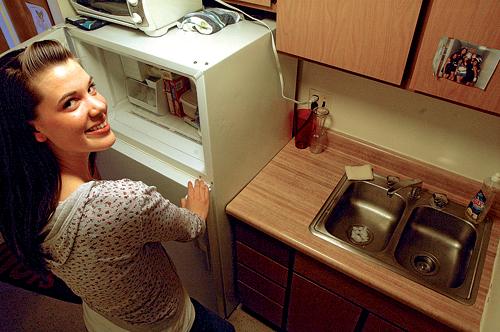What’s in your kitchen?

April 24, 2007
If a student was asked when the last time they cleaned their kitchen was, one may get responses like “I don’t know” or a shrug of the shoulders.
Not cleaning one’s kitchen regularly can make it a breeding ground for harmful bacteria, like E. coli and salmonella.
According to a University of Arizona study found on MSN, the average sponge contains several billion germs. Each time dishes are washed, millions of bacteria are spread all over the plate’s surface, left for the next use and all the uses after that.
Dr. Jim Slauch, associate professor of microbiology, said microwaving sponges can help kill bacteria on sponges but warns that sponges should be thrown out when it’s time to get a new one.
“If you are particularly anal about sponges, you can microwave them for a few minutes,” Slauch said. “It is essentially boiling the sponge and sterilizing it. A vast majority of the organisms on the sponge are sensitive to heat.”
Get The Daily Illini in your inbox!
According to a study on the BBC News Web site, the University of Florida said that microwaving damp sponges for up to two minutes can kill or inactivate up to 99 percent of the bacteria located on the sponge.
However, there are warnings accompanying this method. According to the Web site, it is important to zap damp sponges, not dry sponges, to prevent fires from starting.
According to the Food and Drug Administration Web site, leftovers can remain safe to eat for up to five days, but the site also advises to “throw it out when in doubt,” because it is not worth getting sick.
Slauch said that it’s good practices that determine how long food can be kept for, such as handling and storing.
“Students classically get up in the morning and finish that beer and pizza that was sitting there, and that’s not good practice,” Slauch said. “It depends on the type of food, but it’s proper handling that makes a difference.”
Simple steps can be taken to clean the kitchen and to prevent illnesses caused by harmful bacteria. It starts by taking tasks one at a time, Stacy Suerth, freshman in LAS, said.
“My roommates and I make it a rule to clean up after ourselves,” Suerth said. “The less you let the mess accumulate, the less often you have to clean it up. Plus, it doesn’t hurt that I love cleaning, so it’s not a hassle for me to do.”
Suerth’s roommate, Kendall Ramai, freshman in AHS, agrees with Suerth.
“It’s not hard to keep clean if you just put in a little effort,” Ramai said. “If you clean right away, you don’t have to worry about doing it later. The more you put it off, the more you will dread doing it later.”
According to the FDA, one should wash their hands with warm water and soap for at least 20 seconds. However, it is important to remember that warm water and soap will not kill all strands of bacteria, but it does do a sufficient job.
Slauch said that it is important to note that just a dirty kitchen doesn’t mean that students will get a food born illness. However, the only thing that is certain is good clean practices will prevent unwanted bacteria from growing.
“Students and everyone else should be concerned and practice good food safety, all the time,” Slauch said. “In many respects, it’s common sense, but everyone should be aware of it. It’s just good practices, good clean practices.”






